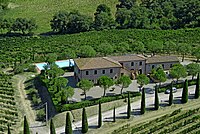
Photo from wikipedia
Purpose This paper aims to analyse the main variables and causal relationships in the system structure of the diversification of non-agricultural activities on agricultural holdings using system dynamics (SD) modelling.… Click to show full abstract
Purpose This paper aims to analyse the main variables and causal relationships in the system structure of the diversification of non-agricultural activities on agricultural holdings using system dynamics (SD) modelling. The SD model aims to simulate depictions of the behaviour of the real system while testing the effects of alternative decisions over time. Design/methodology/approach An SD methodology was chosen to model diversification in farm tourism. Findings A system approach increases the authors' understanding of the transition of agricultural holdings to farm tourism. The results indicate that the transition to farm tourism depends on the level of tourism development in a certain area. The system is influenced by subsidies allocated by authorities to expand primary agricultural activities. The model describes a situation in which the tourism and agricultural industries have been affected by the COVID-19 pandemic. Research limitations/implications The research is limited by the small set of available data due to the limited number of farms in Slovenia. One major problem is the difference in statistical data on the same activity collected from different institutions in Slovenia. Practical implications The paper includes implications for understanding the transition process to farm tourism, allowing policymakers to experiment with subsidies and promotion to explore the efficacy and efficiency of proposed policies. Originality/value This study provides a structured, systemic view of the diversification of non-agricultural activities on agricultural holdings, where the simulation results are a reliable reflection of the behaviour of the actual system being modelled.
Journal Title: Kybernetes
Year Published: 2021
Link to full text (if available)
Share on Social Media: Sign Up to like & get
recommendations!